The OnePlus Open, OnePlus’ first foldable smartphone, is finally official after months of teasing. The smartphone looks familiar to the Samsung Galaxy Z Fold5 (review) with the notebook-like folding design. However, the in-hand feeling is different and dare I say, relatively more polished. That’s because the OnePlus Open feels like a regular smartphone in its folded form. The height and width of the cover display will be familiar to average smartphone users these days. When unfolded, you will witness a beautiful 7.82-inch display with a subtle crease, thanks to OnePlus’s “Flexion hinge” design. The main display can be a multitasker’s best friend as it allows running multiple apps simultaneously.
There’s a lot to say about the hinge mechanism, but there’s still no IP rating for protection against dust particles. Even protection against water splashes is the bare minimum. The OnePlus Open also offers the goodness of premium hardware that makes it worth Rs 1,39,999 for a single 16GB RAM and 512GB storage. While this makes it relatively more affordable than the Rs 1.54 lakh-worth Samsung Galaxy Z Fold5, it’s still not cheap by any means. In that case, is it worth considering? Let’s find out.
Verdict
OnePlus has nailed the main display on the OnePlus Open. There’s barely any crease to notice, making the movie viewing and reading experience fantastic. It’s not highly portable but comparatively lighter than Galaxy Z Fold5 and iPhone 14 Pro Max. Camera performance is decent at best, as low-light photography needs improvement. Similar to other OnePlus devices, the OnePlus Open does not compromise on fast-charging support.
Design and main display
Truth be told, book-style foldables can be challenging to carry and use. It can be tiresome to hold them for longer due to their weight. There’s also a looming fear about their durability. In that respect, the OnePlus Open does not break any legs. However, a bunch of thoughtful additions make me hopeful about its durability in the long run.
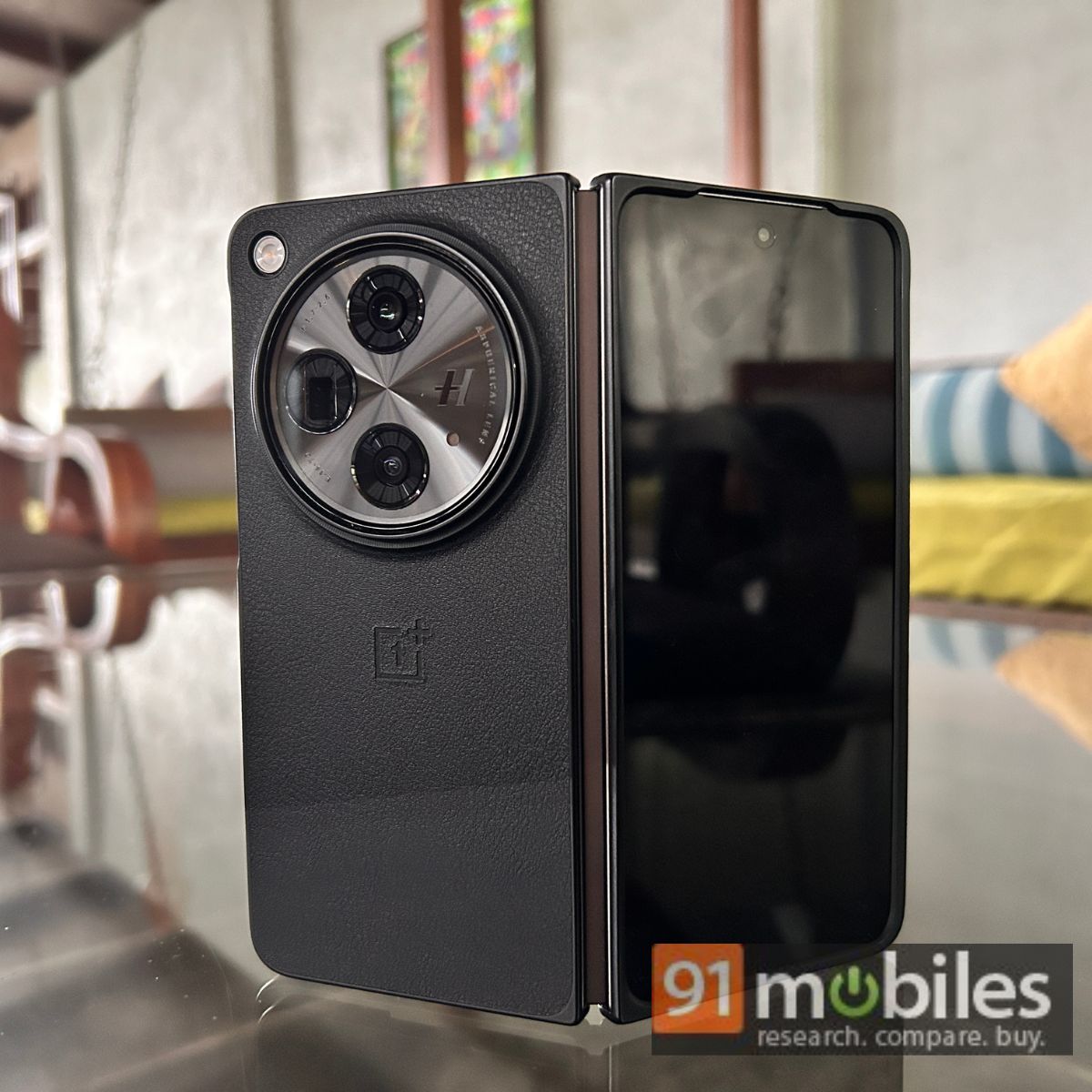
- The Voyager Black colour variant’s leather finish offers a relatively less slippery body. It also protects from easy scratches and fingerprint smudges.
- The OnePlus Open box includes protective cases, which Samsung and Google skip.
- OnePlus claims the OnePlus Open can survive at least a million folds — roughly 547 folds per day for five years. Samsung promises 200,000 folds for the same period.
I did not face any issues with the hinge or durability in usage for around ten days, which includes several safaris in the Andaman Islands. This form factor is generally loud and attracts lots of attention, which I do not mind. For what it’s worth, the OnePlus Open has an IPX4 rating (for water splashes) against Galaxy Z Fold5’s IPX8 rating.
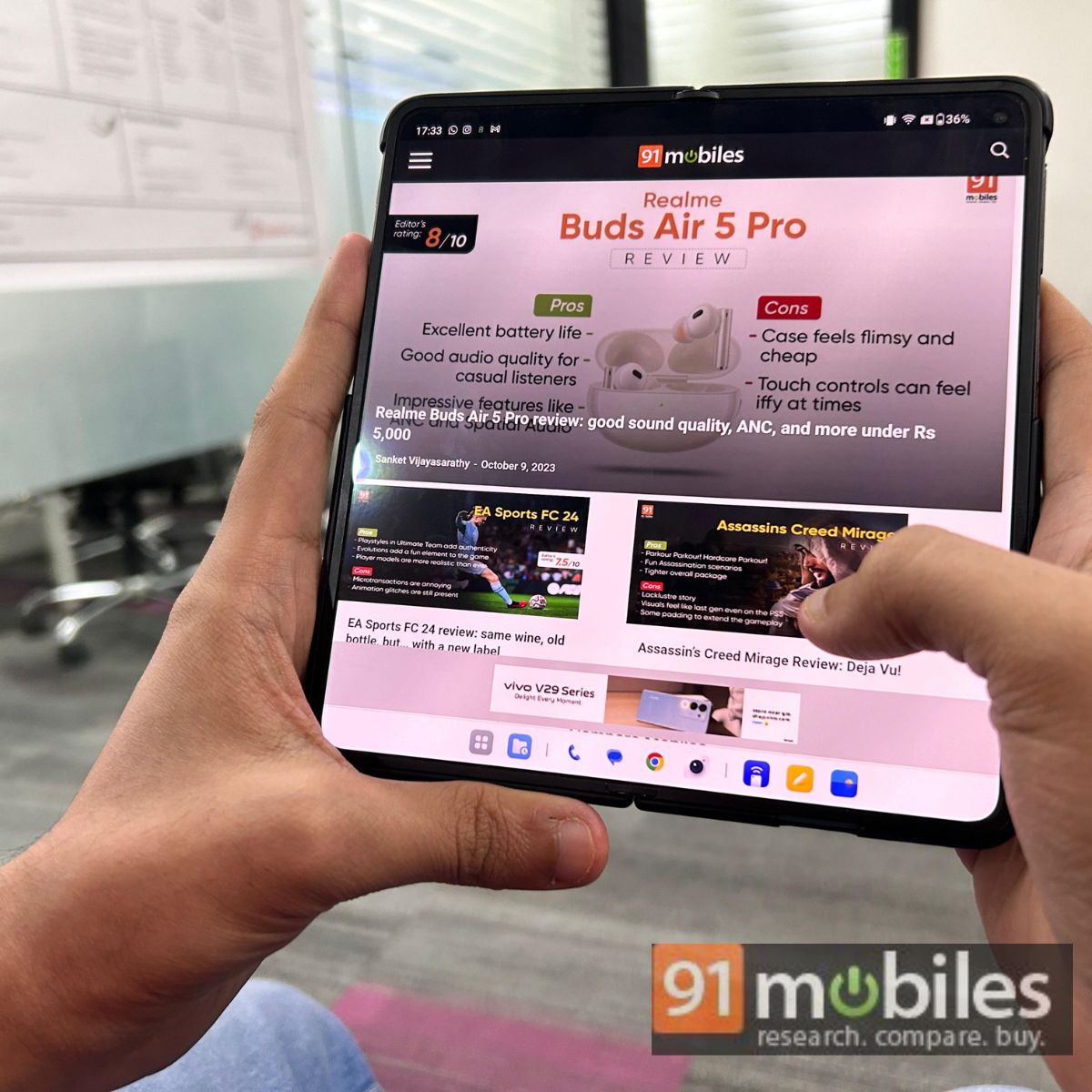
If weight is not your concern, there’s barely anything to dislike. You get the standard buttons (the power button doubles as a fingerprint scanner). The phone also uses a metal frame even for the slider and volume rockers.
For perspective, here’s a comparison between the OnePlus Open and some of its peers. Do note that the Google and Xiaomi foldables mentioned here aren’t available in India officially yet.
| Smartphone | Height (in mm, folded) | Width (in mm, folded) | Thickness (in mm, folded) | Weight (in grams) |
| OnePlus Open | 153.4 | 73.3 | 11.9 | 239 |
| Samsung Galaxy Z Fold5 | 154.9 | 67.1 | 13.4 | 253 |
| Google Pixel Fold | 139.7 | 79.5 | 12.1 | 283 |
| Xiaomi Mix Fold 3 | 161.2 | 73.5 | 10.9 | 255 |
OnePlus has developed a “Flexion hinge” design to minimise the weight and crease on the screen on the OnePlus Open. This design leverages the water drop-shaped hinge design that several foldables are using these days, but somehow OnePlus seems to have done it better. The company is able to reduce hinge components down to 69, which explains a relatively lighter weight. The hinge can easily retain a 90-degree angle without any wobbles. But anything beyond 110 degrees will push the screens to lay flat.
Speaking of screens, the main 7.82-inch 10-bit display offers a 2K (2,400 x 2,268 pixels) resolution. It also offers a variable refresh rate ranging from 1Hz to 120Hz. The OnePlus Opens uses a flexible AMOLED panel with a peak brightness of 2800 nits. In my usage, the primary display offered adequate brightness under harsh sunlight on a beach.
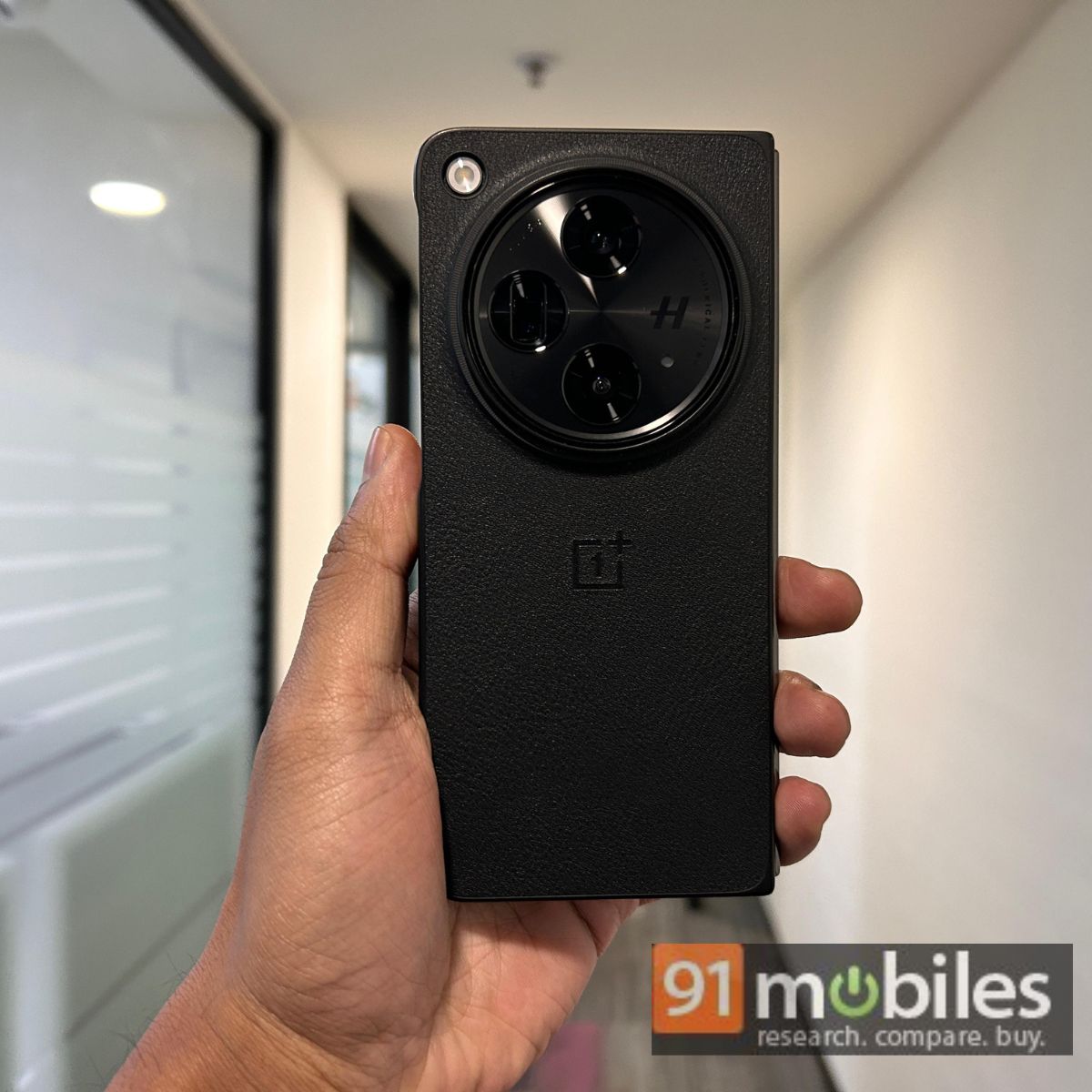
Watching movies on the big screen is equally good, provided the aspect ratio is compatible with the main screen. For example, watching the latest Wes Anderson short films on Netflix was a breeze. However, other movies and shows on the same platform may struggle to fit in fully on the squarish display. Otherwise, the sharpness and colours of the pictures aren’t a problem. The audio is loud, though Apple remains the MVP in the audio department.
Cover screen
The 6.3-inch cover display on the OnePlus Open is perhaps one of the most practical displays on any foldable I’ve seen. The 10-bit AMOLED display provides 2K resolution (2,484 x 1,116 pixels) and a variable refresh rate (10Hz to 120Hz). There’s also a “ceramic guard” screen protector.
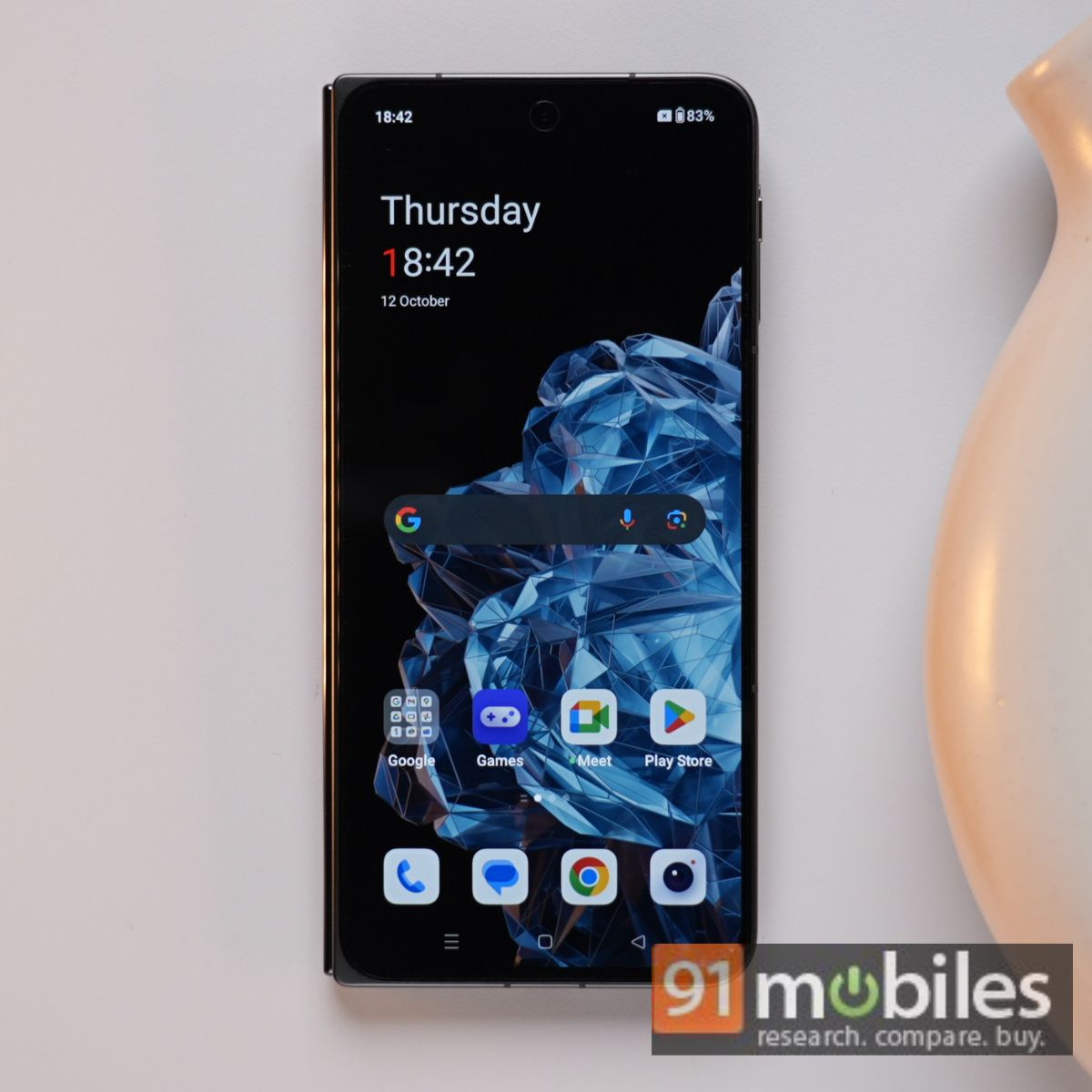
Most apps on the cover display work efficiently, which wasn’t the case on the Galaxy Z Fold5. Even watching Instagram Reels and YouTube Shorts wasn’t an issue, which can be a problem on the main display as they won’t be covered edge-to-edge.
Cameras
Beyond the viewing experience, OnePlus is banking heavily on the cameras, tuned by Swedish camera maker Hasselblad. There are two 48MP cameras on the back (wide and ultra-wide) and a periscope-style telephoto camera (3X optical and 120x digital). The rear cameras come inside a chunky round camera module. The size and thickness of the round camera module may irk some customers, but didn’t bother me. The cover screen has a central hole-punch camera and the main display carries the selfie camera on the top-right.
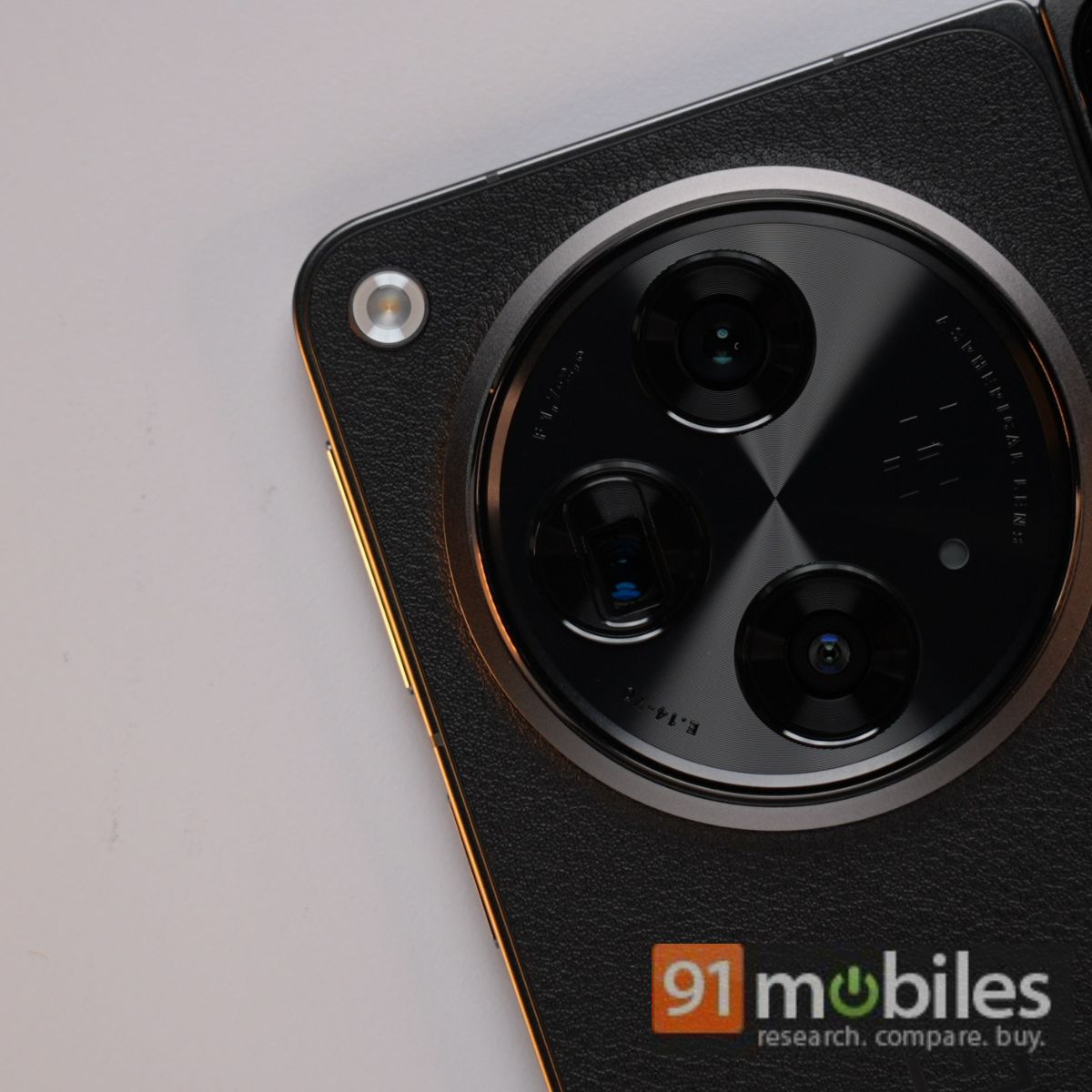
The OnePlus Plus uses a new 1/1.43-inch Sony LYTIA-T808 “pixel stacked” sensor instead of the 1-inch Sony sensor. From a technical perspective, the new sensor is designed to capture more light and stack details within pixels without requiring additional physical space for the camera system. Standalone results are good, but in some cases, Samsung, Apple, and Google offer better performance with their respective flagship smartphones.
For instance, photos taken in daylight with the 48MP Sony LYTIA sensor come with lots of details, though OnePlus continues to make the shots dramatic by manipulating the sky. Some of the photos I took were high in contrast and low in saturation. Somehow, colours appear natural, but face tone mapping needs improvement. You can expect consistent colours and contrast with the ultra-wide camera, but the noise level also increases. In low-light conditions, the OnePlus Open sometimes over-processes the scene with vibrant colours, but this results in a loss of details in certain areas. The software tuning also struggles with minimising the lens flare, which the Pixel 8 Pro does much better.
The telephoto camera, on the other hand, performed surprisingly well. Shots with 3x zoom appear natural, sharp, and with a rich bokeh effect. Even with 6x zoom, which leverages the primary camera, details are surprisingly crisp. But if you’re taking portraits with 6x, the phone can detect skin colour accurately.
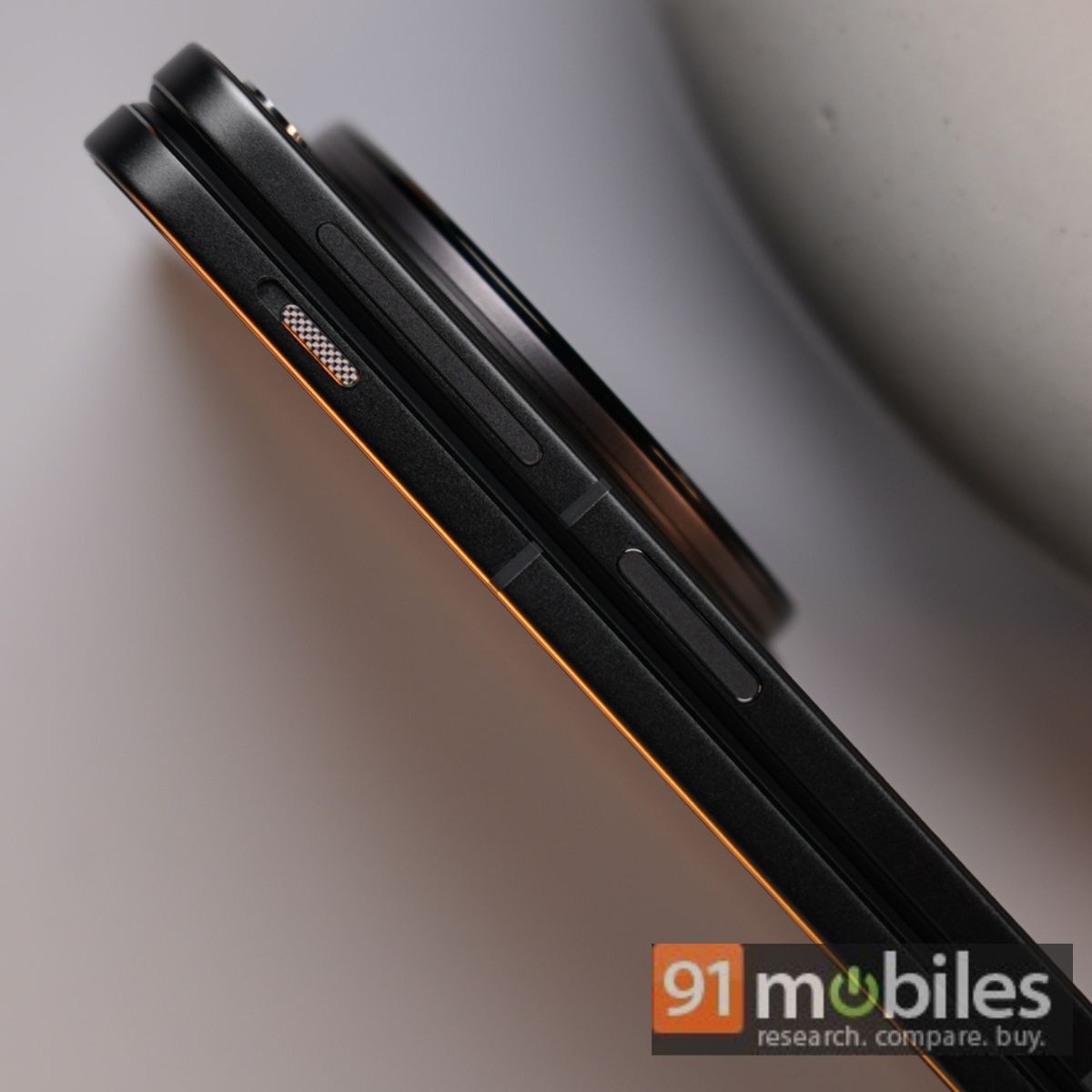
The two selfie cameras are also okay-ish as there’s again inconsistency in results. To be fair, I like selfies better with the OnePlus Open than Galaxy Z Fold5. The advantage of using a foldable is that you can take selfies with the rear cameras and preview the shots simultaneously by enabling cover screen mode. If you like playing around with filters, there are some Hasselblad pre-sets. Otherwise, there are loads of options to play with the ProXDR mode that lets you take RAW images.
Video performance is also decent. There’s also an option to shoot videos with Dolby Vision support for richer details. The OnePlus Open also offers an ultra-stability option in Full-HD resolution, but I am equally happy with the stability in 4K resolution. The mics perform averagely well in capturing the speech but with some degree of ambient noise. In that case, I feel the latest iPhone 15 Pro Max and Google Pixel 8 Pro capture much better and clearer audio.
Software
The OnePlus Open ships with Android 13-based OxygenOS 13.2, Snapdragon 8 Gen 2 SoC, 16GB of LPPRD5 RAM, and 512GB of UFS 4.0 storage. It performed well in our benchmarks, though the Galaxy Z Fold5 with the same processor performed better.
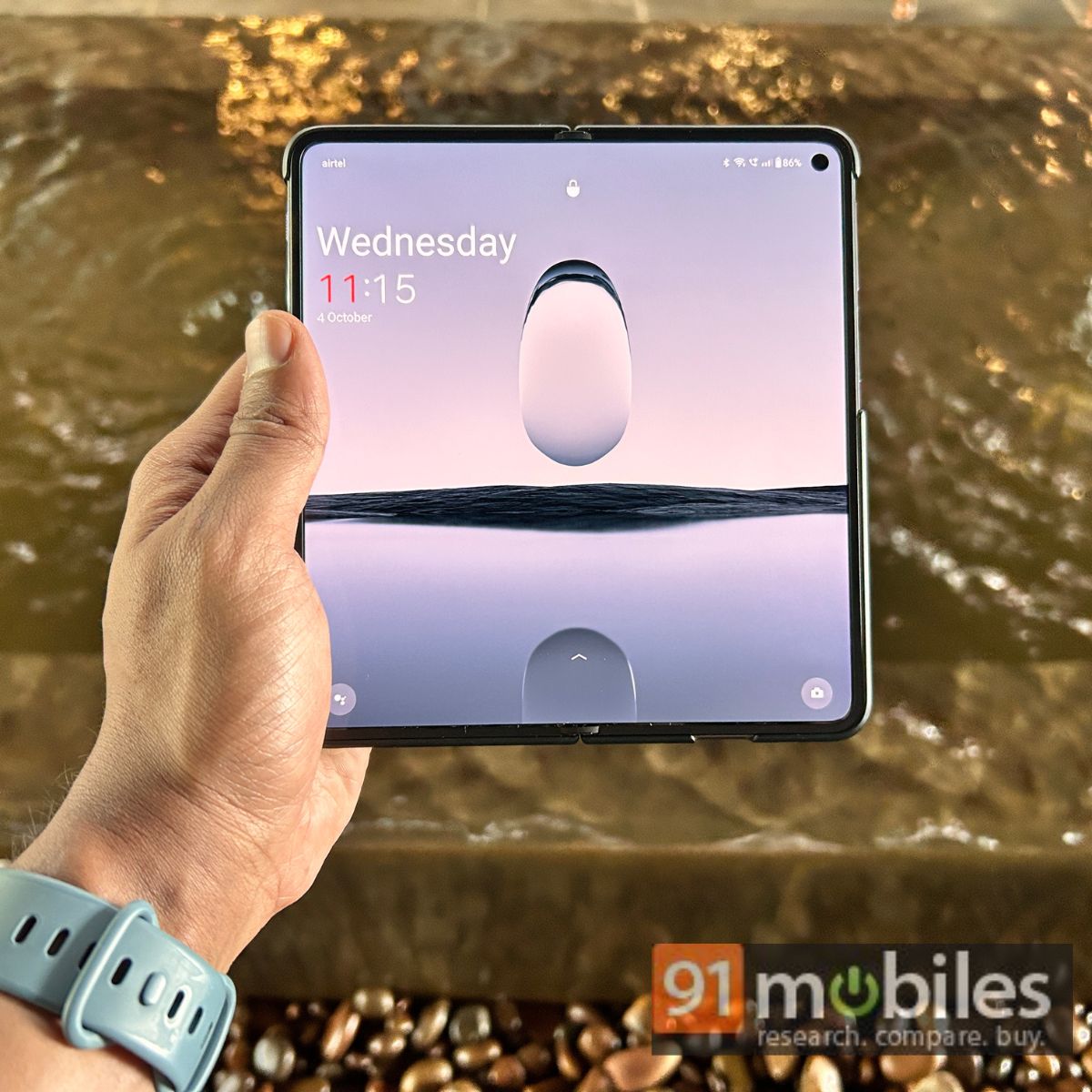
In real-life cases, the OnePlus Open will not disappoint with its multi-tasking abilities. Some apps still require optimisation for the main 6.82-inch display, but OnePlus promises updates in future. I like the app stack at the bottom that stores your frequently used apps (customisable). You can also run three apps simultaneously on the main display, which OnePlus calls “Triple splits”. It works smoothly by dragging and dropping the app on the main display. Since the OnePlus Open has been co-developed with OPPO, it borrows features, like dual-split by swiping two fingers down the middle of the screen. Additionally, if you close the screen, the app running in the foreground will get optimised for the cover screen, provided there’s support.
Similar to Samsung, OnePlus is also promising four years of Android OS updates and five years of security updates. It’s a step in the right direction, even for OnePlus. Overall, the clean Android OS experience will not disappoint, but it will take a few years for OnePlus to offer a comprehensive ecosystem like Samsung or Apple.
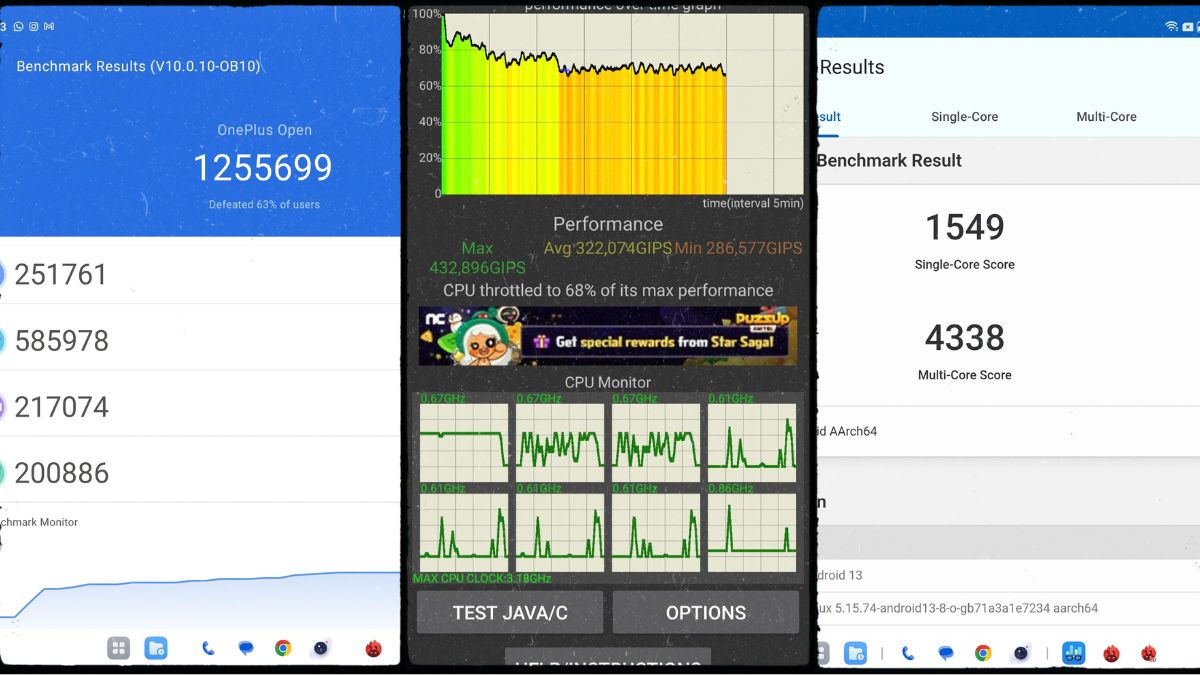
Otherwise, you can always rely on Google apps for multiple-device syncing. OnePlus also has a surprise in the form of an IR sensor to let users control ACs, TVs, and other appliances directly via the phone. This can make your old home appliances “smart” to some degree. I’d still like to see a more comprehensive system from OnePlus.
We also tested the Airtel 5G Plus network on the OnePlus Open in Gurugram, Haryana. It offered good internet speeds and a largely uninterrupted signal. Of course, the strength will vary depending on the location.
Battery
The OnePlus Open carries a 4,805Ah battery with 67W charging – pretty good by foldable standards. In the PC Mark battery test, it lasted over 13 hours, almost the same as the Galaxy Z Fold5. In real life, I got an all-day battery with 120Hz refresh and AOD enabled. I had to charge the device twice a day during my trip to Andaman as it involved heavy camera usage and media playback. You can increase the battery capacity by enabling moderate settings.
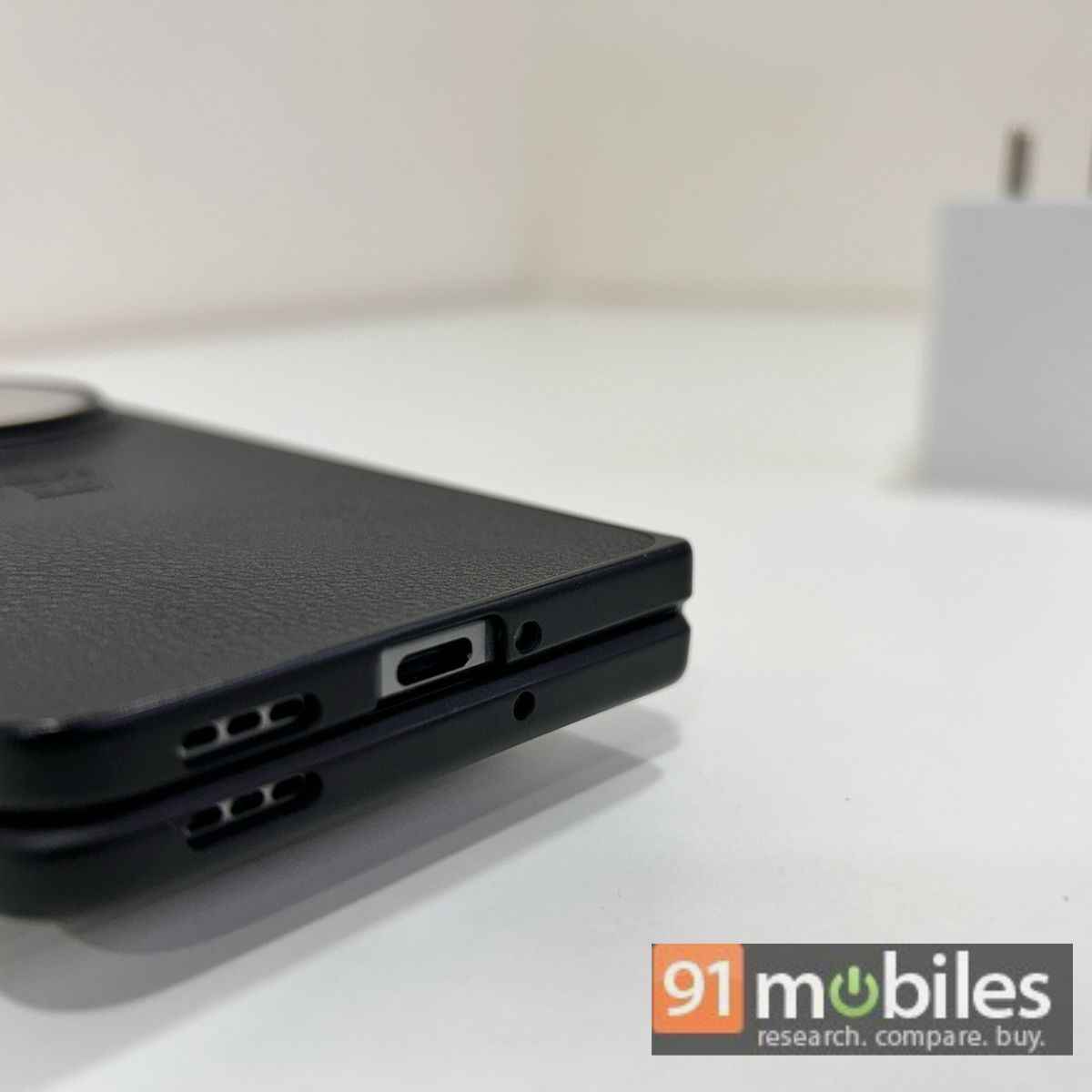
With the bundled 80W charger, the OnePlus Open attained a 40 percent charge in roughly 20 minutes. Full charging took around 50 minutes. There’s no wireless charging support to cap the weight of the device.
Final verdict
While this is OnePlus’ first folding phone, the comparison to Samsung’s fourth-gen Galaxy Z Fold 5 would be obvious. For a first-gen foldable smartphone, OnePlus scores higher in some respects, particularly in design and fast charging. Its close work with OPPO (which already offers OPPO Find Ns) has also resulted in a nearly crease-less display.
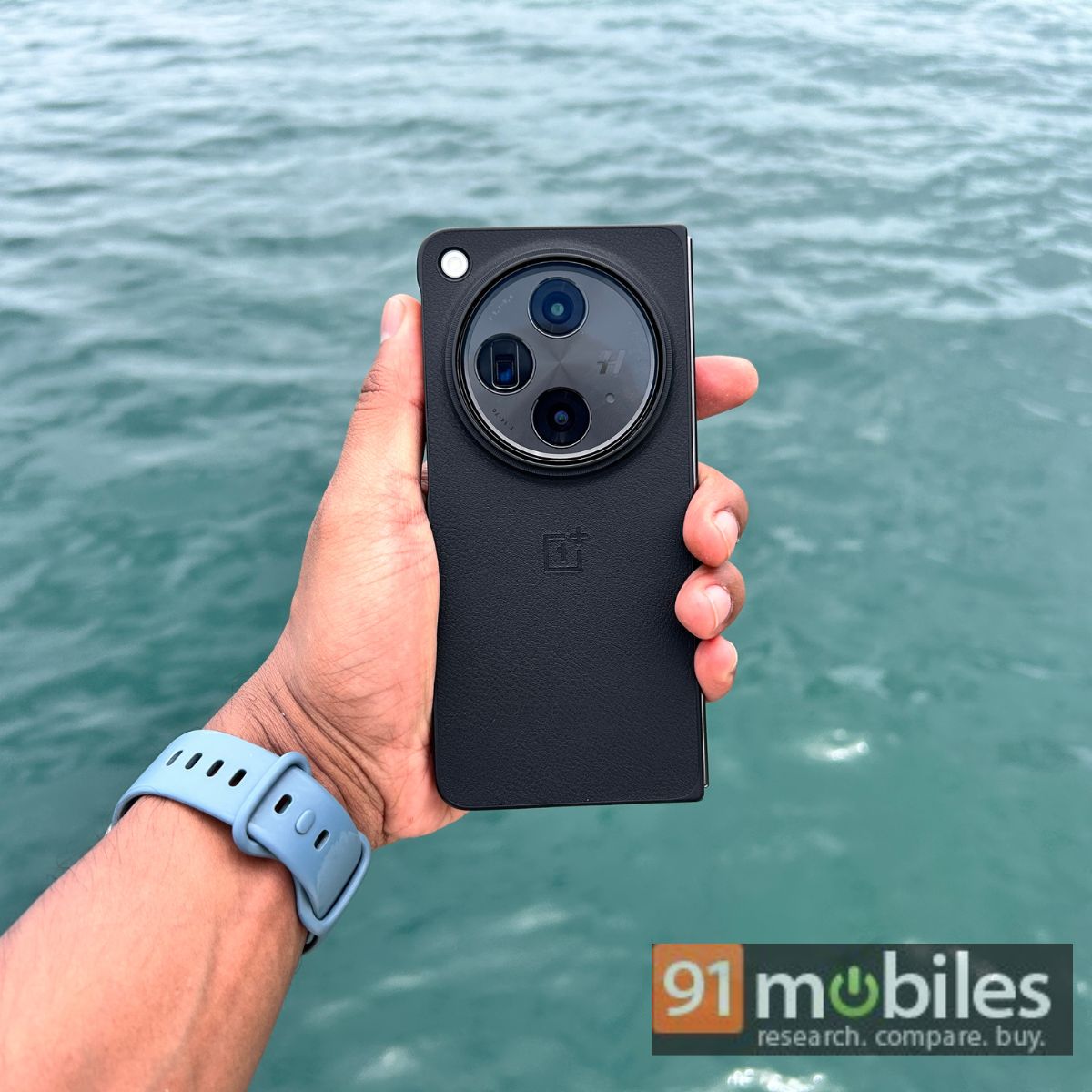
Software-wise, there’s not much to complain about, but I am still waiting for a more intuitive ecosystem. In that regard, Samsung does it better.
But no wireless charging at this price is a no-go. Moreover, the cameras are decent, but OnePlus needs to work to improve low-light photography.
But all that goes aside when we look at the price. With bank and exchange offers, the OnePlus Open will be available for Rs 1,26,999, much more affordable than the Galaxy Z Fold5. Plus, its availability in key global markets may shake competitors’ aggressively by their shoulders. Will that help OnePlus lead the foldable race? Only time will tell.
Editor’s rating: 8/10
Reasons to buy OnePlus Open
- Relatively more affordable than the Samsung Galaxy Z Fold5.
- Great displays. There’s barely any crease to notice on the main display.
- OnePlus Open offers fast charging. Full charge in under one hour.
- Clean Android OS experience. Plus, four years of OS updates promise.
Reasons not to buy OnePlus Open
- Cameras are average, especially in low light.
- The OnePlus Open also does not offer wireless charging to reduce weight.
 OnePlus Open OnePlus Open |
vs |  Samsung Galaxy Z Fold5 Samsung Galaxy Z Fold5 |
 OnePlus Open OnePlus Open |
vs |  Tecno Phantom V Fold Tecno Phantom V Fold |
The post OnePlus Open review: an impressive foldable debut first appeared on 91mobiles.com.
0 Comments